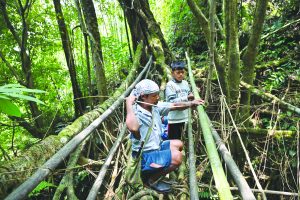By Our Reporter

SHILLONG, June 8: In a proactive move to safeguard Meghalaya’s iconic living root bridges, the United Nations Development Programme (UNDP) has forged a partnership with the Living Bridge Foundation (LBF) and the North East Biodiversity Initiative (NEBI), with the backing of the Government of Germany. These unique bridges, fashioned from living tree roots, have garnered global admiration for their fusion of traditional wisdom and sustainable architecture.
The partnership’s focal point is to document and disseminate the traditional knowledge underpinning these natural wonders. Together, they aspire to establish a ‘Centre of Knowledge’ dedicated to living root architectures. This initiative aims to transmit age-old techniques to younger generations and raise worldwide awareness about the significance of these green infrastructures.
Ashish Chaturvedi, Head of Action for Climate and Environment at UNDP, explained to The Shillong Times what spurred UNDP’s interest in the Living Root bridges, stating, “The living root bridges have been crafted by the Khasi tribe, integrating ecological principles with traditional knowledge, promoting resilience and sustainability. Preserving such cultural heritage aligns with the broader efforts to achieve the Sustainable Development Goals (SDGs), particularly SDG 11 (Sustainable Cities and Communities) and SDG 15 (Life on Land). Living root bridges embody sustainable development by maintaining ecological balance, preventing soil erosion, and fostering community resilience.”
Furthermore, he underscored UNDP’s endeavor to empower women and acknowledge their pivotal role in generational cultural transmission, affirming, “The preservation of living root bridges supports gender equality and enhances community resilience. These efforts ensure that cultural heritage and environmental sustainability go hand in hand, promoting inclusive and sustainable development.
The preservation and protection of these bridges, along with the awareness about protecting the environment, result in the conservation of surrounding forests and green areas, which aligns with the UNDP’s goals.
Living root bridges play a pivotal role in environmental conservation and community resilience. By utilizing natural materials, these bridges combat soil erosion and preserve water, thus contributing to the conservation of local ecosystems. Moreover, they serve as crucial links for remote villages, fostering connectivity and community cohesion.
Chaturvedi elaborated on UNDP’s multifaceted efforts that extend beyond preservation to economic empowerment, stating, “Through community-based tourism initiatives, over 400 households in three villages have received training in guiding, homestay management, and traditional crafts. Additionally, the establishment of fruit processing facilities enhances local agricultural livelihoods, supporting sustainable economic development.”
UNDP, navigating the tribal power structures, respects and closely collaborates with the community. By involving village elders and community leaders in decision-making, UNDP ensures alignment with the values and traditions of the Khasi people. Regular consultations and educational sessions further solidify this bond, fostering trust and cooperation.
These living root bridges transcend mere architectural marvels; they epitomize indigenous knowledge and sustainable practices.
Handed down through generations, the art of crafting these bridges reflects the Khasi tribe’s profound understanding of their natural environment.
The UNDP is prioritizing raising awareness about preserving natural heritage and promoting sustainable architectural practices. Key initiatives include supporting the development of community-based tourism models, educational programmes through the ‘Centre of Knowledge’ for Living Root Architectures, and enhancing local livelihoods through eco-friendly practices.
UNDP encourages individuals and organisations to participate by advocating for the preservation of cultural heritage, supporting sustainable tourism, and promoting traditional knowledge in environmental conservation. By collaborating with local communities and engaging in awareness campaigns, the UNDP aims to inspire collective action toward sustainable development and the protection of natural heritage.



